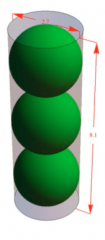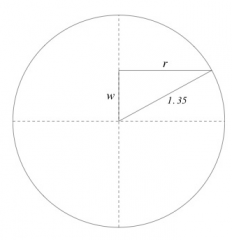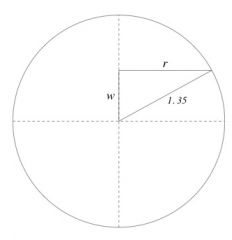![]()
![]()
![]()
Use LEFT and RIGHT arrow keys to navigate between flashcards;
Use UP and DOWN arrow keys to flip the card;
H to show hint;
A reads text to speech;
7 Cards in this Set
- Front
- Back

The official diameter of a tennis ball, is at least 2.575 inches and at most 2.700 inches. Tennis balls are sold in cylindrical containers that contain 3 balls each. To model the container and the balls in it, we assume that the balls are 2.7 inches in diameter and that the container is a cylinder, the interior of which measures 2.7 inches in diameter, and is (3*2.7)= 8.1 inches high. A. Lying on its side, the container passes through an X-ray scanner. If the material of the container is opaque to x-rays, what outline will appear? With what dimensions?
|
The shadow is a rectangle measuring 2.7 inches by 8.1 inches.
|
|
|
The official diameter of a tennis ball, is at least 2.575 inches and at most 2.700 inches. Tennis balls are sold in cylindrical containers that contain 3 balls each. To model the container and the balls in it, we assume that the balls are 2.7 inches in diameter and that the container is a cylinder, the interior of which measures 2.7 inches in diameter, and is (3*2.7)= 8.1 inches high. B. If the material of the container is partially opaque to x-rays and the material of the balls is completely opaque to x-rays, what will the outline look like (assuming the can is lying on its side)?
|

The shadow is alight rectangle (2.7 x 8.1 inches) with three disks inside, looking like this:
|
|
|
The official diameter of a tennis ball, is at least 2.575 inches and at most 2.700 inches. Tennis balls are sold in cylindrical containers that contain 3 balls each. To model the container and the balls in it, we assume that the balls are 2.7 inches in diameter and that the container is a cylinder, the interior of which measures 2.7 inches in diameter, and is (3*2.7)= 8.1 inches high. The central axis of the container is a line that passes through the centers of the top and bottom. If one cuts the container and balls by a plane passing through the central axis, what does the intersection of the plane with the container and balls look like? (This intersection is also called a cross section)
|

The image is a rectangle (2.7 x 8.1 inches) with three disks inside, but only the outlines are seen.
|
|
|
The official diameter of a tennis ball, is at least 2.575 inches and at most 2.700 inches. Tennis balls are sold in cylindrical containers that contain 3 balls each. To model the container and the balls in it, we assume that the balls are 2.7 inches in diameter and that the container is a cylinder, the interior of which measures 2.7 inches in diameter, and is (3*2.7)= 8.1 inches high. D. If the can is cut by a plane parallel to the central axis, but at a distance of 1 inch from the axis, what will the intersection of this plane with the container and balls look like?
|

The intersection with the container is a narrower rectangle. The intersections with the balls are smaller circles. Because the ball touches the container along its whole "equator," the circles must touch the long sides of the rectangle, as seen here.
|
|
|
The official diameter of a tennis ball, is at least 2.575 inches and at most 2.700 inches. Tennis balls are sold in cylindrical containers that contain 3 balls each. To model the container and the balls in it, we assume that the balls are 2.7 inches in diameter and that the container is a cylinder, the interior of which measures 2.7 inches in diameter, and is (3*2.7)= 8.1 inches high. E. If the can is cut by a plane parallel to one end of the can- a horizontal plane- what are the possible appearances of the intersections?
|

The intersections are two concentric circles, except when w=0, 2.7, 5.4, 8.1 and when w=1.35, 4.05, 6.75. In the former case, we see a circle (from the container) and a point (where the plane touches a sphere). In the latter case, we see a single circle corresponding to a place where the equator of a ball touches the container.
|
|
|
The official diameter of a tennis ball, is at least 2.575 inches and at most 2.700 inches. Tennis balls are sold in cylindrical containers that contain 3 balls each. To model the container and the balls in it, we assume that the balls are 2.7 inches in diameter and that the container is a cylinder, the interior of which measures 2.7 inches in diameter, and is (3*2.7)= 8.1 inches high. F. A cross-section by a horizontal plane at a height of 1.35+w inches from the bottom is made, with 0<w<1.35 (so the bottom ball is cut). What is the area of the portion of the cross section inside the container but outside the tennis ball?
|

The intersection of the plane with the interior of the container is a disk of radius 1.35 inches. Its area is PI(1.35)² in². The intersection with the ball is a smaller disk that is contained in the firt disk. The radius r of the smaller disk is the square root of (1.35)²-w², as we see from the diagram depicting the intersection of a plane through the central axis of the container with the bottom ball. Thus, the area of the smaller disk is π((1.35)²-w²). Accordingly, the area inside the larger disk but outside the smaller is πw², provided that 0<w<1.35.
|
|
|
The official diameter of a tennis ball, is at least 2.575 inches and at most 2.700 inches. Tennis balls are sold in cylindrical containers that contain 3 balls each. To model the container and the balls in it, we assume that the balls are 2.7 inches in diameter and that the container is a cylinder, the interior of which measures 2.7 inches in diameter, and is (3*2.7)= 8.1 inches high. G. Suppose the can is cut by a plane parallel to the central axis but at a distance of w inches from the axis (0<w<1.35). What fractional part of the cross section of the container is inside of a tennis ball?
|

Referring to part D, we see that we wish to find the ratio of the total area of three congruent disks to the area of a rectangle, one of whose dimensions is equal to the diameter of the disks. The same picture used in the previous problem, but interpreted as a view from one end of the container, gives us the radius of the small disks- namely, √(1.35)²-w², so the total area of the disks is 3π((1.35)²-w²). The area of the rectangle is (8.1)2√(1.35)²-w². So, the ratio is:
3π((1.35)²-w²)/ (8.1)2√(1.35)²-w² = π√(1.35)²-w²/5.4 |

